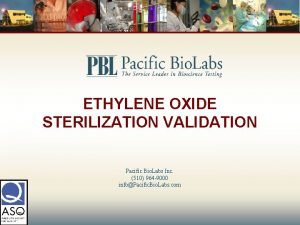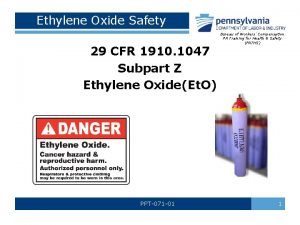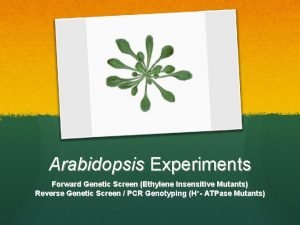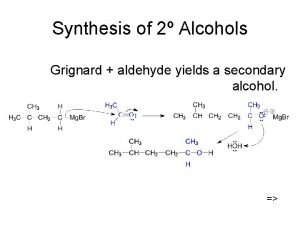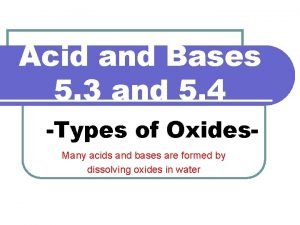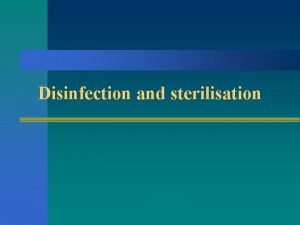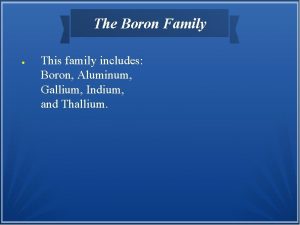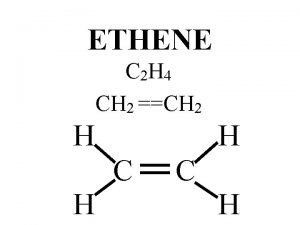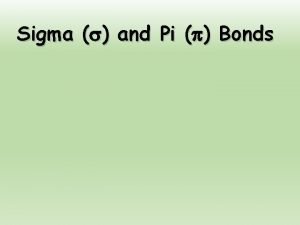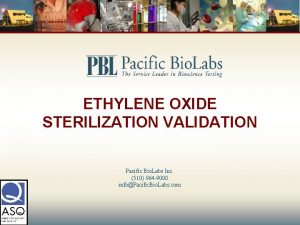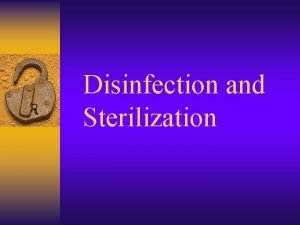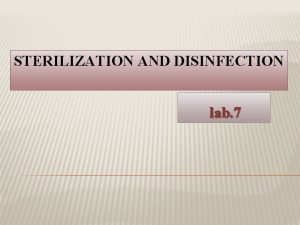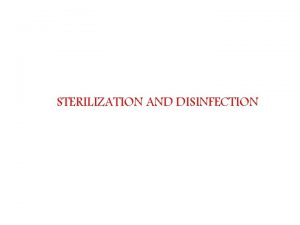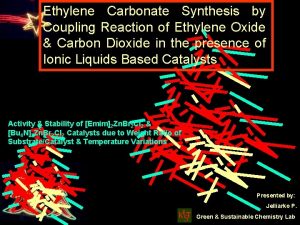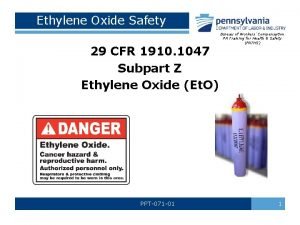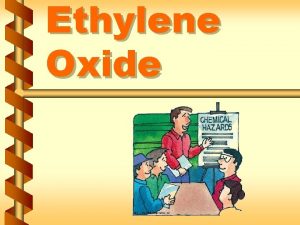Chemical Sterilization 1 Gas Ethylene oxide H 202












- Slides: 12

Chemical Sterilization 1. Gas Ethylene oxide H 202 Gas Plasma 2. Liquid Glutaraldehyde Cold Packs *For items that cannot withstand high heat or steam Ex. Plastics, power equipment, fiber optic equipment

Gas Sterilization: Ethylene Oxide At room temperature is a colorless gas, flammable, explosive, and toxic (carcinogenic) skin burns, respiratory irritation, headaches, birth defects Requires special unit with proper ventilation and proper training emergency protocols in place Ampules should be stored in a cool, safe place Emitted into environment through a vent hose o Most of ETO is converted to C 02 and H 20 o MSDS and OSHA

Gas Sterilization: Ethylene Oxide Can sterilize long, plastic tubes Packs must only be wrapped in crepe paper or plastic pouches No liquids!

Ethylene Oxide Use Multiple packs are placed in a specific plastic bag, along with: o Glass ampule containing liquid (on top) o Dosimeter (in center of bag) o Humidity chip (gas needs minimum of 35% to destroy microorganisms) o Biological indicator (optional) Bag is sealed and placed in the unit and air is vacuumed out You must then break ampule, and close and lock door quickly Ran for 12 hours at room temperature


*Must air out for 12 hours in a hood/ventilator or 7 days in a well ventilated area Anprolene® is most common brand Require annual safety inspections and preventative maintenance

Gas Sterilization: Hydrogen Peroxide Gas Plasma Cannot be used for wood, paper, linen, some plastics, liquids No endoscopes; no tubes longer than 12 inches Expensive Advantages: By-products- water vapor and O 2 Cycle only takes about an hour VIDEO

Gas Plasma Use Packs placed in chamber (in special material) Vacuum evacuates air Hydrogen peroxide is injected from a cassette and vaporized initiates destruction of microorganisms After 50 minutes the pressure is lowered and radio waves create gas plasma Free radicals kill microorganisms, along with UV light Chemical indicator- shows H 202 was present Biological indicator – checks functionality of machine

Liquid Sterilization Cold Sterilization – soaking instruments in disinfectant to eliminate microorganisms o Cold tray packs – stores instruments used in minor or “dirty” procedures OR endoscopy • 3 hours contact time; changed regularly • Instruments must be dry before use! Ex. Dental, minor wounds, laparoscope

Examples: • Chlorhexidine solution • Benzalkonium – better for anti-rust properties • Glutaraldehyde

Glutaraldehyde 20 minutes = sterile Used mainly for endoscopes Will usually expire 30 days upon opening Must rinse instrument before using on living tissue!

Sterilization Method Steam Advantages • Nontoxic to patient, staff, environment • Cycle easy to control and monitor • Rapidly microbicidal • Rapid cycle time • Can sterilize liquids Disadvantages • No good for heat-sensitive instruments • May leave instruments wet, causing them to rust • Potential for burns Hydrogen Peroxide Gas Plasma • Safe for the environment • Leaves no toxic residuals • Cycle time is 28 -75 minutes (varies with model type) and no aeration necessary • Used for heat- and moisturesensitive items since process temperature • Simple to operate, install (208 V outlet), and monitor • Only requires electrical outlet • Paper, linens and liquids cannot be processed • Some endoscopes or medical devices with long or narrow lumens cannot be processed at this time in the United States (see manufacturer's recommendations for internal diameter and length restrictions) • Requires synthetic packaging (polypropylene wraps) 100% Ethylene Oxide (ETO) • Penetrates packaging materials, device lumens • Single-dose cartridge and negativepressure chamber minimizes the potential for gas leak and ETO exposure • Compatible with most medical materials • Requires aeration time to remove ETO residue • ETO is toxic, a carcinogen, and flammable • ETO emission regulated by states but catalytic cell removes 99. 9% of ETO and converts it to CO 2 and H 2 O • Lengthy cycle/aeration time • Emitted to environment
